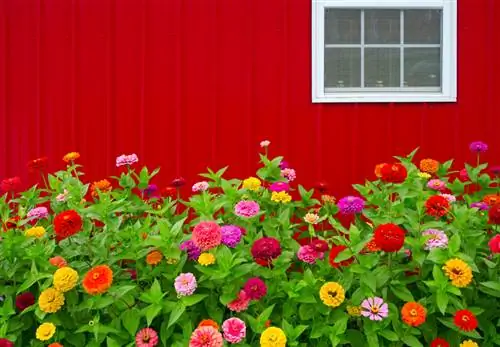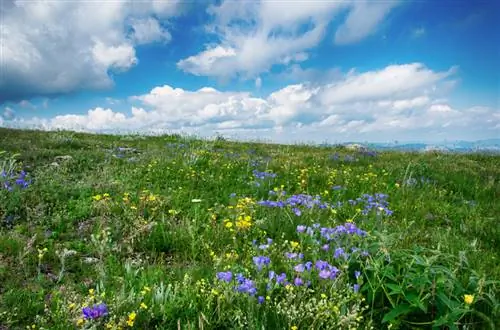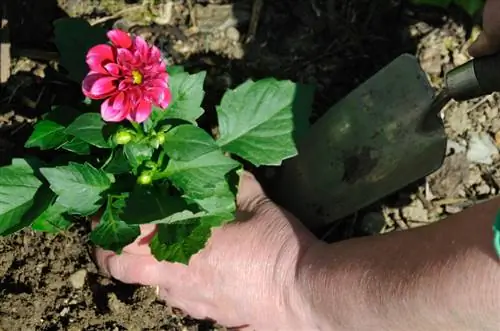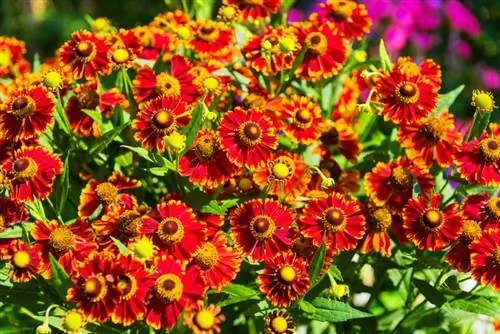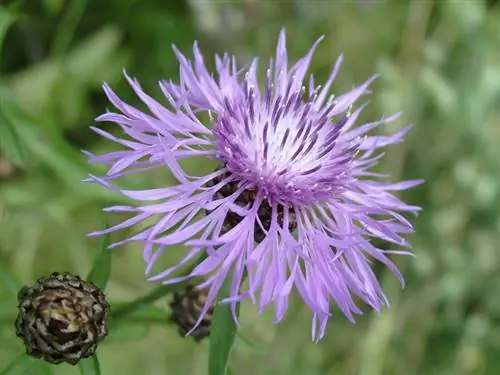- Author admin [email protected].
- Public 2023-12-16 16:46.
- Last modified 2025-01-23 11:20.
Zinnias add the finishing touch to an imaginative cottage garden. The lavish summer flowers with their bright colors and tightly upright habit act as decorative structural plants, eye-catching potted plants and magnificent gap fillers in perennial beds. These answers to frequently asked questions shed light on the care that is important to the annual Zinnia.
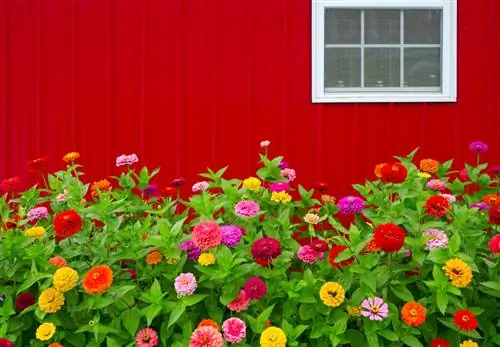
How do I care for zinnias in summer?
Zinnias are easy-care annual summer flowers that bloom from July to October. They prefer a sunny, warm location and well-drained, rather poor soil. Regular watering and light fertilization promote growth and flower formation. Withered flowers should be removed to make room for new buds.
Planting Zinnia correctly
Do not plant your pre-grown or ready-made zinnias in the bed before mid/late May. A cold snap sets back the flower's growth dramatically. Prepare the soil in full sun so that it is loose and well-drained. If in doubt, add a few handfuls of sand or grit to clayey soil. This is how planting can be done even by an inexperienced hand:
- Dig spacious pits at a distance of 25-40 cm depending on the selected variety
- Add a little compost with horn shavings to the excavation
- Insert a potted young plant into each planting hole, maintaining the previous planting depth
- Press the soil with your hands and water it
In the first few days and weeks, water your Zinnia regularly to encourage rooting. As a result, the water requirement is reduced to a low level.
Care tips
We are always surprised at how little care the zinnia requires. Here's how to properly respond to these modest demands:
- Adult flowers should only be watered in dry summer conditions
- From June until the end of the flowering period, fertilize every 14 days with compost in the bed and liquid fertilizer in the pot
- Once a month, sprinkle the ground with nettle and comfrey liquid
- Clean out wilted flower heads every few days
- Support towering flower stalks with a stick
The Zinnia species and varieties cultivated in our regions are not hardy. In late autumn, remove the plants from the ground and dispose of them in the compost.
Which location is suitable?
The Zinnia requires a full sun, warm location. When there is a lack of light or in cool temperatures, the abundance of flowers falls far short of expectations. Combine this with a permeable, rather poor soil that is sandy-loamy and not too moist.
What soil does the plant need?
Plant the sun-loving Zinnia exclusively in lean, humus-poor and well-drained soil. A moderately dry moisture content is of utmost importance, because too much moisture will quickly end the flower's life. For cultivation in pots, this means that normal potting soil can be used; Of course, only on the condition that you add sand, fine grit, lava granules or perlite.
When is flowering time?
If the zinnia finds a sunny, warm and well-drained location, it produces tirelessly bright flowers from July to October. Clean out the withered basket flowers consistently, because the next buds are already waiting underneath to compete with the sun.
Cut zinnia correctly
The upright flower stems invite you to use them as vase decorations or in summer bouquets. Prune newly bloomed zinnias early in the morning after the dew has evaporated. Leave a few leaves on the plant so that it can sprout again. We also recommend cutting off the withered flowers as soon as possible. So the zinnia invests its floral energy in the growth of new flowers instead of wasting it on the growth of seed heads.
Watering Zinnia
The water requirements of a zinnia are at a low level. The summer flower copes much better with short-term dryness than with permanent wetness. Therefore, only water a well-grown plant when the summer is dry. Experience has shown that the watering can is used less often in beds than on potted flowers. Use normal tap water, which you apply directly to the root disc.
Fertilize Zinnia properly
In the bed, the summer flower is happy about a portion of compost every 14 days. Rake in the organic material superficially and water again. In addition, experienced hobby gardeners spray the soil once a month with a mix of nettle and comfrey manure. If the zinnia thrives in a pot or balcony box, apply a liquid fertilizer for flowering plants every 2 weeks.
Wintering
The heat-loving zinnia weakens at temperatures below 15 degrees Celsius. The sensitive summer beauty is therefore not suitable for overwintering. In late autumn, remove the root balls from the soil to dispose of them in the compost.
Propagate Zinnia
For propagation, collect the 5-8 mm long seed heads in autumn before the flowers distribute them in the garden on their own. Stored dry in a screw-top jar in a cool cellar, you will have enough seeds in your hands for sowing from the end of February. Sow the seeds on peat sand or seed soil, sieve them thinly and moisten with a fine spray. When placed in a heated indoor greenhouse, a constant temperature of 18-22 degrees Celsius is required for germination. Prick the strongest seedlings with at least 2 pairs of leaves into individual pots. Until the planting season begins in mid/late May, keep the soil slightly moist in a sunny, warm window seat.
Zinnia in a pot
The Zinnia is just as demanding of its gardener in the pot as it is in the bed. Be particularly careful not to get the flower's feet wet. An airy, light substrate with clay shards as drainage effectively prevents waterlogging. Only water when the soil is completely dry. Be more generous when it comes to nutrient supply. From June to October, apply a liquid fertilizer every 2 weeks or give a slow-release fertilizer in stick form in June and August. Don't forget to clean out the wilted flowers. This care is rewarded with a well-groomed appearance and a consistent abundance of flowers.
Is Zinnia poisonous?
The Zinnia is classified as a slightly poisonous ornamental plant. The plant sap contains various alkaloids and other substances that can trigger skin allergies upon contact. Therefore, wear protective gloves when working around your summer flowers.
Beautiful varieties
- Cherry Red: Award-winning variety that features double cherry-red flowers around a yellow center; 30-40cm
- Envy: A magnificent Zinnia elegans, whose dahlia-like flowers shine in bright yellow; 70-90cm
- Crystal White: The white-yellow flowers are reminiscent of daisies and bloom from June until the first frost; 45-50cm
- Scarlet Flame: The 13 cm large, rich red flower balls attract everyone's attention in the bed and pot; 90-100cm
- Oklahoma Rosa: A pink-flowering zinnia with a tightly upright habit; very beautiful cut flower with a height of 70 cm
- Senorita Aztec: Beautiful cactus zinnia with ruffled and tapered petals in red; 80-100cm

